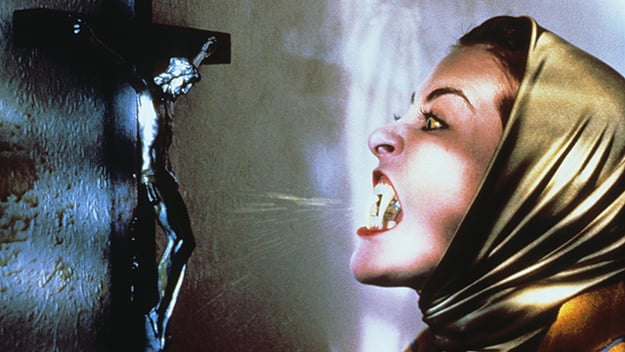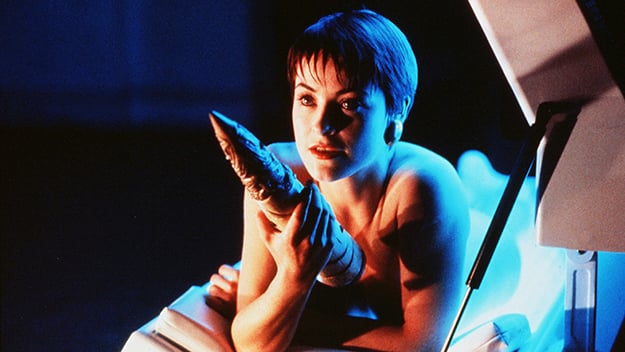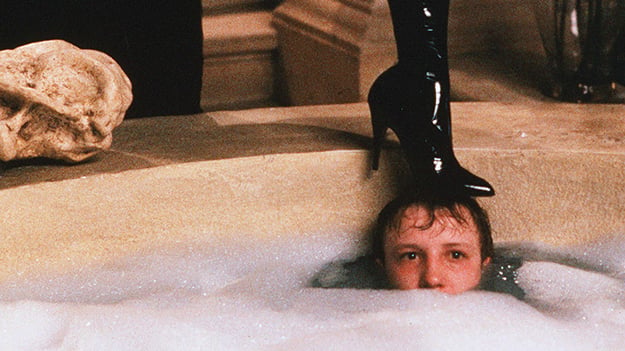Classified: The Lair of the White Worm
Classified is a regular column on genre by April Wolfe.

Amanda Donohoe in The Lair Of The White Worm (Ken Russell, 1988)
There’s a decision every genre director must make when plotting their films: how much should the audience know about the villain? How much should they identify with them? Ken Russell’s answer to that question for his adaptation of one of Bram Stoker’s more obscure folktales, The Lair of the White Worm, ended up birthing one of the most deliciously wicked cinematic villains of all-time, Lady Sylvia Marsh (Amanda Donohoe). That’s primarily because Russell allowed the audience to follow this ancient-evil snake woman from one fangy quip to the next, while the hapless heroes of the film continually tumble into her traps, like high-art Looney Toons, all amidst periodic nightmare sequences of Roman soldiers raping nuns before a totem of evil. This is Ken Russell, after all.
Russell could have focused the story more centrally on local nobleman Lord James D’Ampton (Hugh Grant), whose ancestor—according to lore—slayed the D’Ampton Worm, a wily snake-like beast he will eventually have to slay himself. But Russell, as always, was more energized by evil, and evil is rewarded. It is Lady Sylvia who’s given the slickest lines and asides. “The script’s peppered with little witticisms and in-jokes, nods to the audience to bring them in and have a bit of fun,” Russell said in the Blu-ray commentary, admiring his lithe, alluring villain. “[Lady Sylvia is] the one making underground cracks all the time.”
Allowing a character to reveal their sense of humor is also a means of revealing their intelligence. Lady Sylvia is smarter than the bumbling policeman who willingly walks into her lair for help with, ironically, a snake bite. She’s smarter than the intrepid boy scout bathing in her tub like a sacrificial lamb, smarter still than Lord D’Ampton, than his friends Kevin (Peter Capaldi) or Mary (Sammi Davis) and Eve (Catherine Oxenberg). They’re pawns in her ancient game, and their only chance for escape is dumb bravery.

The Lair Of The White Worm (Ken Russell, 1988)
Yet the winky relationship Russell establishes between Lady Sylvia and the audience is a risk for a genre film, often because the more one gets to know their villain, the more charismatic they become in the viewer’s mind, rendering the vanilla good guys inert—the more inured to Chucky or Freddy Krueger audiences became as those series wore on, the less those audiences cared for their victims’ emotions and fates. In The Lair of the White Worm, which gives equal time to villain and hero, Russell chooses to lean into the comedy of the hero’s plucky naivety, as when D’Ampton wanders into Lady Sylvia’s lair on a rainy night and guilelessly asks her if she has children, setting up her witty retort: “Only when there are no men around.” The filmmaker revels in making the audience squirm over the D’Ampton’s babe-in-the-woods cluelessness.
Horror films today rarely risk alienating viewers with overly dewy-eyed heroes. So when a filmmaker wants to draw more attention to their female villain, he or she may do away with the hero altogether to avoid the problem. Consider Nicolas Pesce’s haunting black-and-white coming-of-age story The Eyes of My Mother (2016), in which the villain is also the lead, a young woman who mutilates and holds a man captive in her barn so she can have a “friend”; the people she kills are but funny, tragic blips in the film. The same goes for Lucky McKee’s May (2003), in which a young woman similarly kills people to harvest their body parts to build a doll friend. These two films, along with others like Deborah Haywood’s Pin Cushion (2017), Joachim Trier’s Thelma (2017), or Julia Ducournau’s Raw (2016), however, belong to a very long line of genre films in the vein of Brian De Palma’s Carrie (1976) that depict the lead female as both victim and villain. There are no heroes, just the villain and her fractured psyche.

The Lair Of The White Worm (Ken Russell, 1988)
In The Lair of the White Worm, however, Lady Sylvia’s psyche is singular: she wants to eat people and have fun, eternally. She stands apart in genre cinema, where women very rarely get to be as cunning and fun as their male counterparts unless it’s part of typical abuse storylines. So often it’s revealed to the heroes that a female villain is acting this way because she endured some form of torture, sometimes emotional but often sexual. (Misery’s Annie Wilkes is perhaps the most obvious departure from this trope, as her fanaticism is thankfully never explained.) There exists now an impulse to explain the pathology of a woman’s evil, possibly an overcorrection for too many millennia of oversimplified virgin/whore characters. Take the recent horror films Rings or Lights Out, which take great pains to wobble through a female villain’s case history, leaving not much room for personalities beyond the pathology. Also, compare Rings, an American film in the Samara Morgan The Ring franchise, to the Japanese addition to Samara’s lore, Sadako vs. Kayako. The former attempts to “heal” the villain’s emotions; the latter accepts that evil’s just evil and is all the more fun and funny for it.
Russell takes the Sadako vs. Kayako tack and wastes no such time diagnosing the villainess in Lair: Lady Sylvia’s simply selfish and zealous. And she’s delighted to show you she is pure poison—she’s no camouflaged garter snake. Russell even slathers Lady Sylvia in vampy red lipstick and makeup, and pins her up in skin-tight leather-and-lace couture, while D’Ampton and his friends are clad in baggy Lands’ End knockoff cable-knit sweaters and boots. But ultimately, Lady Sylvia’s potency as a villain also comes with her ability to embrace the spectrum of gender expression. She is equal parts masculine and feminine, to the extreme; at one point she appears in cerulean blue skin, breasts bare, with a giant brass phallus strapped to her hips. Russell seems to delight in that kind of sexual confusion, poking fun at binaries, whether it’s that of male and female, good and evil, or god and the devil. What’s so wonderful about Russell’s quintessential female villain is that she embodies a sense that evil has no gender. It has no feelings. It simply is, and it’s quite fun to get to know it.
April Wolfe is formerly lead critic for LA Weekly. She currently hosts the Switchblade Sisters podcast, and has written for The Village Voice, AV Club, the Washington Post, and The Wrap.







